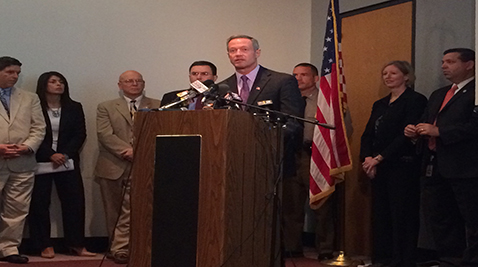BALTIMORE — Maryland state health officials are learning from the mistakes made at a Texas hospital that have left two nurses who cared for an Ebola patient infected with the disease themselves, Gov. Martin O’Malley and Department of Health and Mental Hygiene Secretary Dr. Joshua Sharfstein said during a press conference Friday in Baltimore.
“I think that any potentially lethal infectious disease, it’s important to approach it with a certain degree of humility and learn from all the experiences that can happen,” Sharfstein said.
Nurses Nina Pham and Amber Vinson were both confirmed to have Ebola after treating patient Thomas Eric Duncan at a Dallas-area hospital. Duncan has since died.
Vinson has been moved to Emory University in Atlanta for treatment, while Pham has been been transferred to the National Institutes of Health in Bethesda for care.

O’Malley said he got the call from Health and Human Services Secretary Sylvia Burwell about Pham being moved to NIH on Thursday.
“We have the best public health institutions in the world located in our state,” O’Malley said. “So I wasn’t terribly surprised at that movement, and there may well be others as we isolate and contain Ebola here.”
While the Centers for Disease Control and Prevention has never specifically said how Ebola was transmitted from Duncan to the nurses, Director Tom Frieden said “a variety of forms of protective personal equipment were used.”
Because it’s possible the nurses could have been exposed to Ebola by not adorning or taking off the equipment correctly, or even wearing the appropriate amount of protection, Sharfstein said the events “really have enforced the need to get personal protective equipment right every time.”
Officials from Johns Hopkins Hospital and the University of Maryland Medical Center said they are working very hard to ensure their providers know exactly how to use the equipment.
“To ensure that they know how to put it on properly, every piece of it so that they achieve that full-body coverage and protection that is needed,” said Dr. Lisa Maragakis, director of the Department of Epidemiology and Infection Control at Johns Hopkins. “And that they are, in particular, practicing how to remove the equipment without contaminating themselves.”
She said they’ve also implemented the “buddy system,” which means a health care provider no longer gets in and out of the protective equipment themselves. Now it’s a three-person job, Maragakis said.
All emergency medical service providers in the state, as well as law enforcement at all levels also have the equipment — or at least the ability to request it — to protect themselves effectively from an Ebola patient, said Dr. Richard Alcorta, acting co-executive director of the Maryland Institute for Emergency Medical Service Systems.
He also said all public safety, commercial ambulance services, 911 dispatchers and their medical directors are now screening all 911 calls to identify patients at risk for Ebola so that those callers can be transported to a hospital and treated with the appropriate protective protocols.
“We look at this as part of our system’s responsibility to you, the public, and to the health care professionals to make sure they can take care of all patients and maintain our infrastructure in a robust fashion,” Alcorta said.
Health officials said they continue to meet with leaders across their agencies and push out information to the public.
Dr. Anthony Harris of the University of Maryland Medical Center said he has had “numerous multi-disciplinary meetings and committees” to review hospital protocols and keep everyone abreast on the latest Ebola information. Health Secretary Sharfstein also said a memo went out Friday to all state employees with facts about Ebola.
Additional cautions are also being put into place. Johns Hopkins Hospital has started initial Ebola screenings at all emergency departments and outpatient locations, said Maragakis.
And the state’s biosurveillance system, Electronic Surveillance System for the Early Notification of Community-based Epidemics, has teamed up with the District of Columbia and Virginia health officials and hospitals to aggregate data about people reporting Ebola virus symptoms, said Dr. Laura Herrera, the deputy secretary for Public Health Services for the Department of Health and Mental Hygiene.
While there have been no confirmed cases of Ebola in Maryland, health officials say the chance is still likely.
But O’Malley said we can’t live our lives in fear and that “citizens should go about their normal lives.”
“And they should be aware that their public health networks and public health institutions are very focused on this,” O’Malley said.


You must be logged in to post a comment.